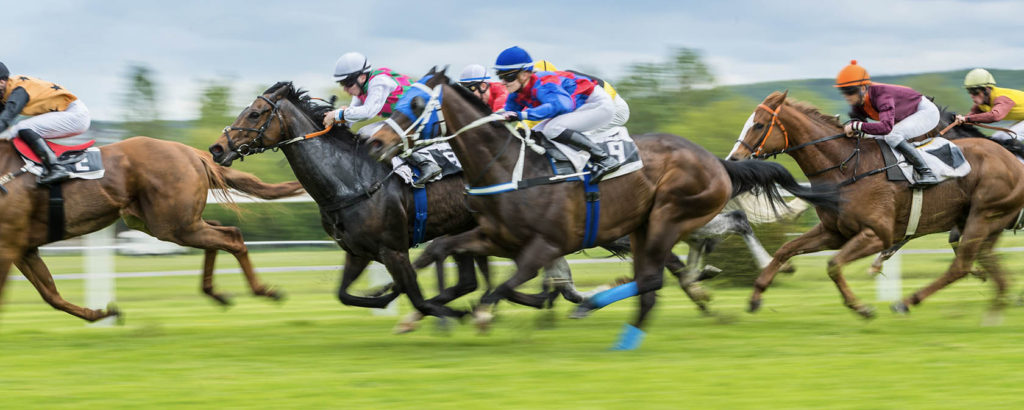
English Thoroughbreds in the breeding of sport horses – hardly any other topic is as present in breeding discussions as this one; it truly is a perennial issue.
By Dr Ludwig Christmann
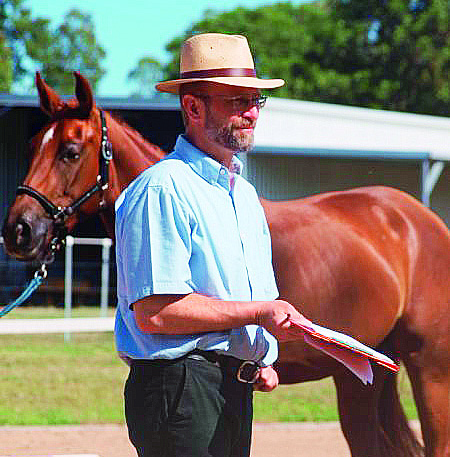
At present, the main complaint in sport horse breeding is that the number of mares bred to Thoroughbred stallions continues to decline. At the beginning of March in Verden, at an open round-table discussion on the issue of breeding event horses, Ulrich Hahne, breeding director of the Hannoveraner Verband, shared that, in 2021, only 39 foals by Thoroughbred stallions were registered for the Hannoveraner Verband.
This raises the question: Is this a real problem with regard to the quality of our horses or is the use of Thoroughbred stallions actually no longer necessary?
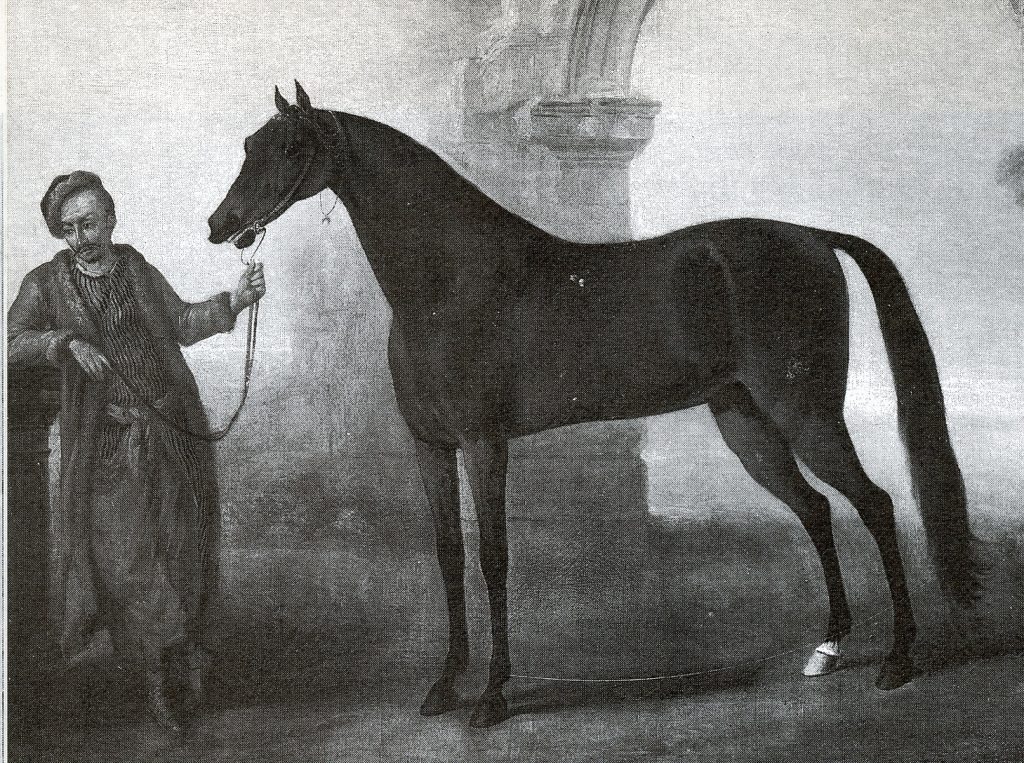
The Godolphin Arabian – one of the founding sires of the Thoroughbred…
With respect to the development of the international sport horse breed, the influence of English Thoroughbreds cannot be valued highly enough. Internationally, there is probably no breed that has influenced the breeding of sport horses as much as the Thoroughbred horse has, whose breed was founded in England for racing only.
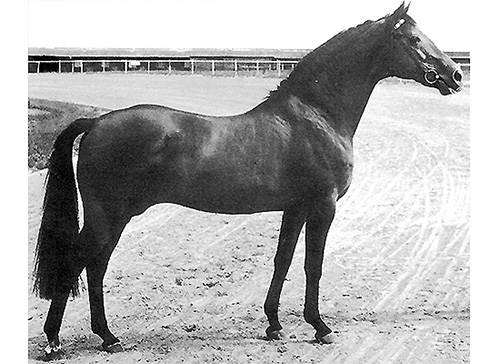
Ladykiller xx – classic Thoroughbred lines, an important sire in Holstein
From the beginning, Thoroughbreds were bred for performance. Only what happened on the racetrack counted! In accordance with the statement ‘Form follows Function’, a horse developed with the typical type and exterior features. The English Thoroughbred contributed significantly to the type design of the modern sport horse: The horses became nobler and lighter, the pasterns longer. The topline, which is useful for the sport horse, remained and so did the saddle position with a long, sloping shoulder and pronounced withers. Less favorable – especially for the dressage horse – is the sometimes somewhat low-set neck. These are purely physical characteristics. At least as important are mental characteristics such as intelligence, sensitivity and quickness of reaction – the special spirit – which, together with the Thoroughbred‘s physique, lead to more athleticism combined with ease of movement.
The short connection
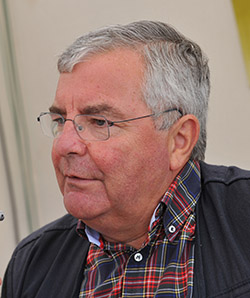
Arnaud Evain, a well-known breeding expert from France, has summed this up very clearly: “We expect a certain quickness of mind from the Thoroughbred. As a rider once said to me – a short distance between the leg and the brain. A horse can have a long neck or a short neck, but the short connection between your leg and your hand to his brain – that‘s what we call blood. In the 1970s, only the Thoroughbred had that quality – now we have a lot of warmbloods with the same quality.”
The quote is from a 2010 article written by the Australian journalist Christopher Hector, and published in Breeding News and www.horsemagazine.com. With his horse magazine, Chris Hector is a brilliant observer of the international breeding scene.
Almost all of the stallion lines used in the Hannoveraner breed today were founded by a Thoroughbred stallion, and successful lines were developed with many Thoroughbred mares. Soon after the General Stud Book – to which all Thoroughbred horses are traced – was published in England in 1793, the Thoroughbred also conquered continental Europe.
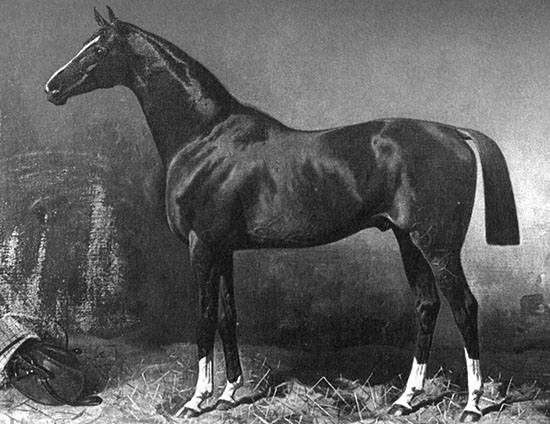
Kingdom xx, a State Stud stallion at Celle between 1882 – 1898
In Germany, the first horse race with Thoroughbreds took place in Doberan in 1822, and already in the first half of the 19th century, the use of the English Thoroughbred in the Hannoveraner breed reached a peak. In 1841, the share of Thoroughbred stallions at the State Stud Celle was 35 percent. 73 Thoroughbred stallions were in service at the state stud at that time. At Celle‘s stud Otersen, for example, nine stallions stood at stud in 1839, six of which were Thoroughbreds covering 408 out of 509 mares in that year (i.e. about 80 percent).
Thus, the English Thoroughbred was anchored in the Hannoveraner lines at an early stage. However, the horses then became too light and the Thoroughbred influence decreased. Around 1900, only three percent of the Celle’s state stud sires belonged to the English Thoroughbred breed. At that time, the suitability of the horses for the military was still the top priority. However, they also had to be able to be used for farming, and there was an additional interest in racing. After Germany lost World War I, the military was cut back. More emphasis was placed on the use of horses in farming, which led to a wave of reinforcement. At about the same time, the equestrian sport started to develop with the founding of numerous riding and driving clubs.
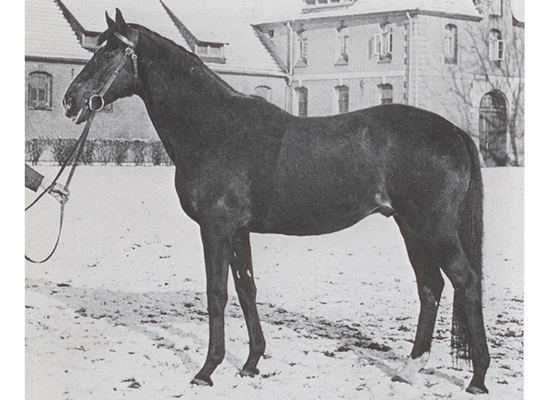
Der Löwe xx, his influence is still felt today in the pedigrees of dressage horses…
Breeding horses experienced a major break during the period after World War II. The motorization in farming started to more and more replace the horses. They now were bred exclusively as riding and sport horses. At this time a refinement phase became necessary, during which primarily English Thoroughbreds were used in Hannover, including stallions such as Der Löwe xx, Marcio xx and Pik As xx, as well as Trakehners and, to a somewhat lesser extent, Anglo-Arabians.
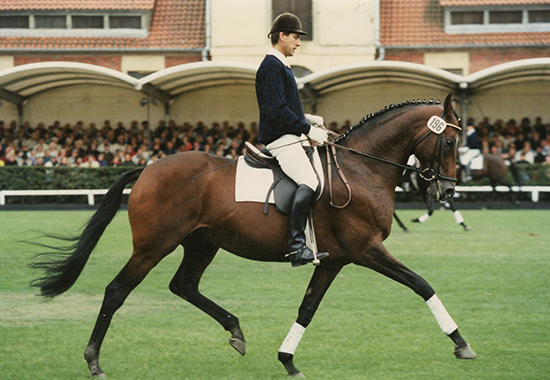
Lauries Crusador xx, the big influence on Hanoverian breeding…
The use of Thoroughbred stallions peaked for the first time in 1970, when they covered about eleven percent of all mares. A second peak occurred in 1990, when Thoroughbreds accounted for twelve percent of coverings. One stallion had a large share in this: It was Lauries Crusador xx, born in 1985. At that time, the mark of ten percent was formulated as the desirable share of Thoroughbreds in the coverings.
The job is done
For more than 60 years, the breeding goal in Hannover has thus been to exclusively produce riding horses. About 30 years ago, with the development of the show jumping program, the specialization primarily for the disciplines of show jumping or dressage started. This exclusive concentration on equestrian sports marked a new era in the breeding of warmblood horses. Gone are the waves of reinforcement.
Since then, it exclusively is about the noble, blood-influenced horse. 60 years – which spells six generations, when you consider an average generational interval of ten years in the breeding of horses. You can definitely achieve something in terms of breeding in this time frame. The breeding goals that we aimed for with the use of the Thoroughbred, have largely been achieved. We have succeeded in breeding and consolidating the desired blood-influenced type of horse, which means that this type is safely passed on from one generation to the next. However, this also means that the refinement phase is largely complete.
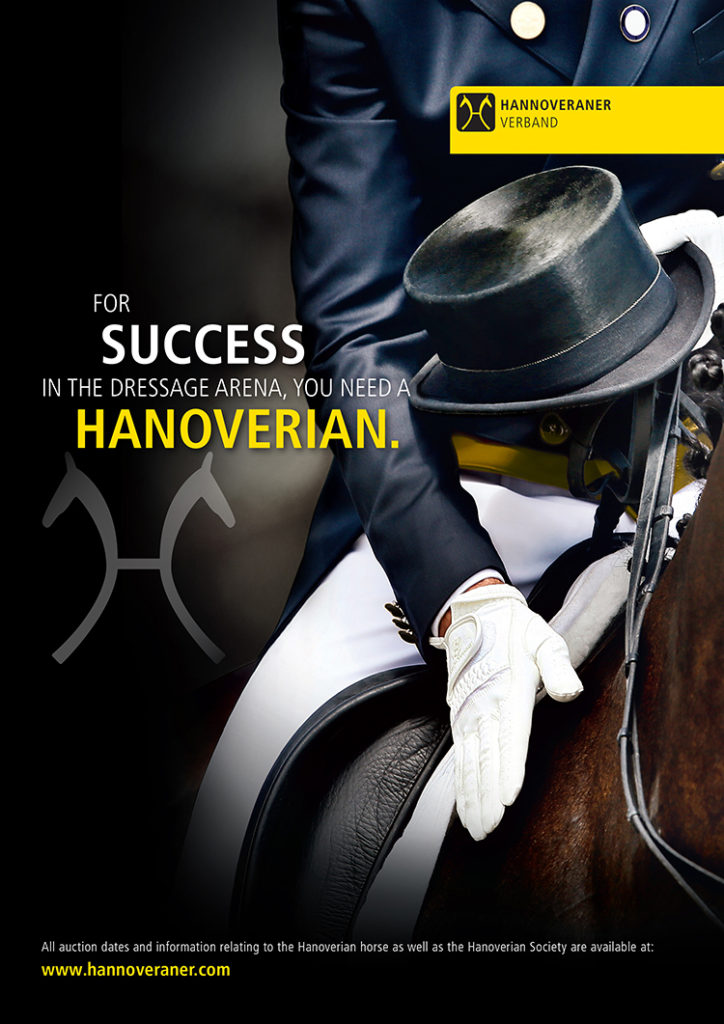
Dr. Florian Sitzenstock, today a professor in stockbreeding at the Osnabrück University of Applied Sciences, researched how strongly the English Thoroughbred is anchored in the Hannoveraner breed. In 2008, he wrote his doctoral thesis on Crossing of English Thoroughbred-blood into the Hannoveraner Warmblood population. In an evaluation of the share of Thoroughbred blood in four ancestral generations of foal crops from 1980 to 2006, he found that although the use of Thoroughbred stallions decreased from 11.8 per cent to 3.3 percent in the period from 1992 to 2006, the percentage of Thoroughbred-blood increased from 20 to 25 percent during the period from 1980 to 2006.
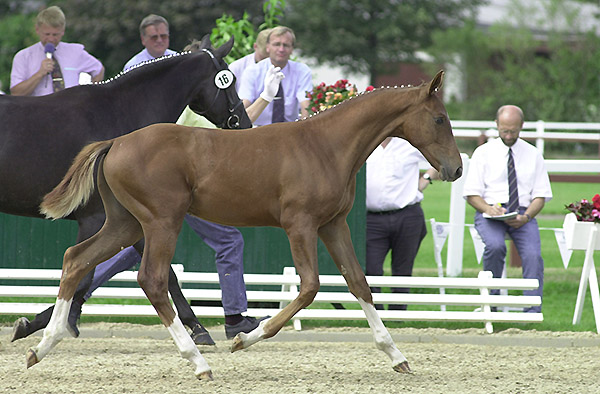
Ludwig – on the right – taking notes on Verden Auction foals in 2000
“In 2006, there were less than one percent of foals whose pedigrees did not contain an English Thoroughbred, while this was the case for 15 percent of foals born in 1980.”
The situation is similar in Germany’s neighboring countries. In the already mentioned article of Christopher Hector, Arnaud Evain describes the situation in France: “Today there are sport horses that do not have a Thoroughbred ancestor in the first three generations, but they still have a lot of blood. If you look at the pedigrees of French horses, the percentage of Thoroughbreds has stabilized between 15 and 20 percent, a situation which is similar in the Netherlands.“ He draws an interesting comparison, fitting for France as a country, which enjoys the pleasures in life: “If you mix a drink with 20 percent of alcohol with another with 20 percent of alcohol, you still have 20 percent of alcohol. It is the same with our horses. We breed a horse with 20 percent of Thoroughbred blood to another horse with 20 percent and get the same share of Thoroughbred blood.”
New definition of a blood horse
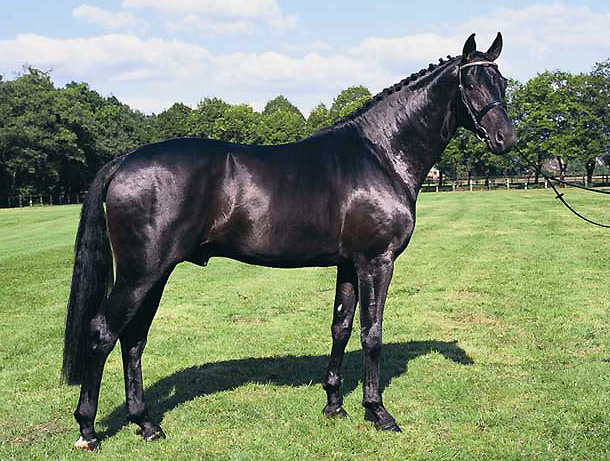
Sandro Hit – the new’blood horse’
Now this is an interesting point. In most stallions and mares, some Thoroughbred percentage is anchored in the back of the pedigrees and many positive characteristics of the blood horse have been preserved. So one attains a whole new definition of a blood horse. Paul Schockemöhle describes his top sires Sandro Hit (one Thoroughbred ancestor, Sacramento Song xx, born in 1967, in the third generation) and Diarado (two Thoroughbred ancestors in the fourth generation: Amarpour xx, born in 1966, and Rantzau xx, born in 1946) as blood horses, which definitely pass on the characteristics of a blood-influenced horse.
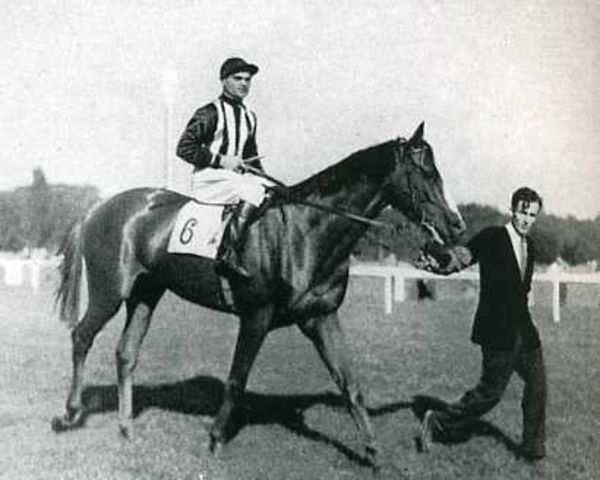
Rantzau xx, another huge influence
The Hannoveraner stallions Perigueux (not a Thoroughbred in the first four generations, but further back) and Escudo (a Thoroughbred ancestor: Novum xx, born 1957, in the fourth generation) would also fit into the same category, as they have proven their refining potential through their heredity.
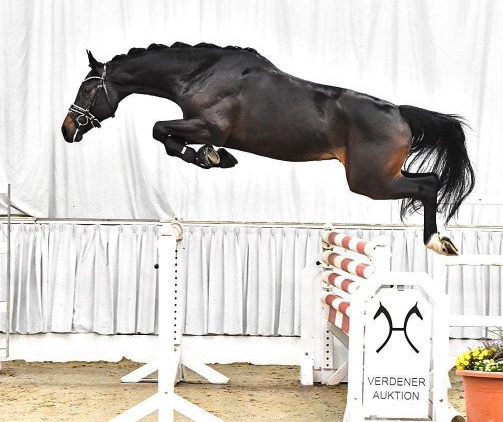
Doom Pur: Foto Beelitz
In this regard, Celle’s State Stud Manager Dr Axel Brockmann raves about his young stallion Doom Pur by Doom SR/Aktion Pur DB Z, which he purchased at Verden’s licensing in 2021: “He is super light, agile, fast in his reflexes and can be used like a blood horse.“ Yet he doesn‘t have a Thoroughbred in the first generations. So there are definitely Hannoveraner, Holstein and Oldenburg stallions as well as stallions from other Warmblood populations that can be used as refining sires.
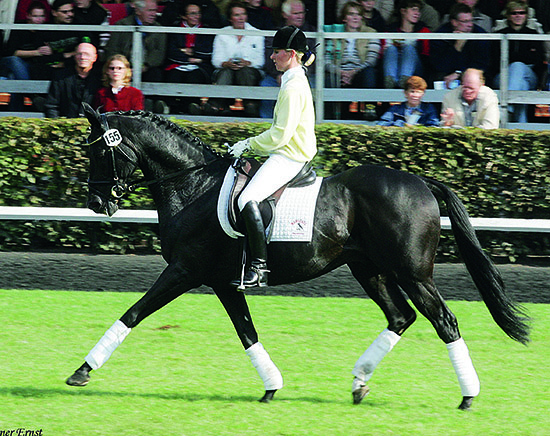
Sunlight xx, movement and type (photo – Werner Ernst)
Looking at the breeding values in his dissertation, Dr Florian Sitzenstock found out that the aptitude and conformation for dressage were positively influenced by an increasing share of Thoroughbred blood. This effect became particularly evident when the share of Thoroughbred blood was found in the generation of the grandparents. Regarding the breeding values for jumping, there was, however, a clearly negative correlation between the breeding values and the share of Thoroughbred blood. This result should not be generalized, as it was due to the unique situation in Hannover. The most important Thoroughbred stallions of the study period were Lauries Crusador xx, Prince Thatch xx and Sunlight xx – all stallions that had been used because of their movement, type and conformation and mainly brought positive impulses to the breeding of dressage horses.
It is interesting to look at the share of Thoroughbreds in the first four generations of each of the top 100 dressage and show-jumping horses in the FEI World Rankings (year-end 2021). The basis for this is the pedigrees, which can be found on the internet at www.Horsetelex.de. There, the share of Thoroughbred blood is shown, which is calculated over nine generations. Ancestors who belonged to the refining breeds like the English Thoroughbred, Anglo Arabian or Arabian Thoroughbred breed were taken into account.
Dressage: (five Lusitanos or PRE were not counted)
- 31 horses (32.3 percent) had no Thoroughbred or Anglo-Arabian genetics in the first four generations.
- 51 (53.2 percent) horses had one or more refining ancestors (Thoroughbred or Anglo-Arabian) in the fourth generation at the earliest.
- Eleven horses (11.5 percent) had one or more refining ancestors (Thoroughbred or Anglo-Arabian) in the third generation at the earliest.
- Only three horses (3.1 percent) had one or more refining ancestors (Thoroughbred or Anglo-Arabian) already in the second generation. These were Bella Rose (Isabell Werth) as well as the two Hannoveraner horses Faustus (Dorothee Schneider) and Statesman (Naima Moreira Laliberte, Canada).
- No horse had a Thoroughbred/Anglo-Arabian as its sire or dam.
A good 85 percent of the horses therefore either have no Thoroughbred or only one or more ancestors in the fourth generation at the earliest. Nevertheless, according to Horsetelex (i. e. calculated over nine generations), the medium share of refining blood is 33.4 percent. Only the above-mentioned five Spanish horses show a refining share of zero; in the other horses, it varies between 17.97 percent (Fürst Ferdinand zur Fasanenhöhe, bred in Bavaria and number 94 in the world rankings) and 51.76 percent for the already mentioned Statesman by Sandro Hit/Brentano II, whose maternal grandam is a Thoroughbred mare.
Jumping (an Irish horse was not included because the maternal lineage was not available):
- 5 horses (25.3 percent) had no Thoroughbred or Anglo-Arabian genetics in the first four generations
- 51 horses (51.5 percent) had one or more refining ancestors (Thoroughbred or Anglo-Arabian) in the fourth generation at the earliest.
- 20 horses (20.2 percent) had one or more refining ancestors (Thoroughbred or Anglo-Arabian) in the third generation at the earliest.
- Three horses (3 percent) had one or more refining ancestors (Thoroughbred or Anglo-Arabian) already in the second generation. These were two Selle Français-horses with a high share of Anglo-Arabian blood and one horse with Irish breeding, where traditionally a lot of Thoroughbreds were used in breeding show jumpers.
- No horse had a Thoroughbred/Anglo-Arabian as sire or dam.
According to the data from Horsetelex, a mean percentage for refinement of 43 percent was calculated, which is almost ten percent higher than in dressage horses. The range was between 19.92 percent for the purely Hannoveraner-bred King Edward (number 2 in the world rankings, Henrik von Eckermann) and 61.52 percent for the Selle Français gelding Usual Suspect d‘Auge, who was ridden by Julien Epaillard, among others.
This evaluation shows how much refining blood accumulates further back in the pedigrees; and that in top competitions in the disciplines of dressage and jumping, positive effects of the blood-influence often become apparent after three or four generations. There is no need to analyze the refining blood components of top event horses, because here it is clear: Without Thoroughbred blood, it does not work.
This was also made very clear at the above-mentioned discussion meeting on the subject of eventing at the beginning of March in Verden. Although there are more and more horses in eventing where the Thoroughbred blood is not found in the first generation, there is a clear tendency that the more difficult the competitions are, the higher the percentage of Thoroughbred blood is.
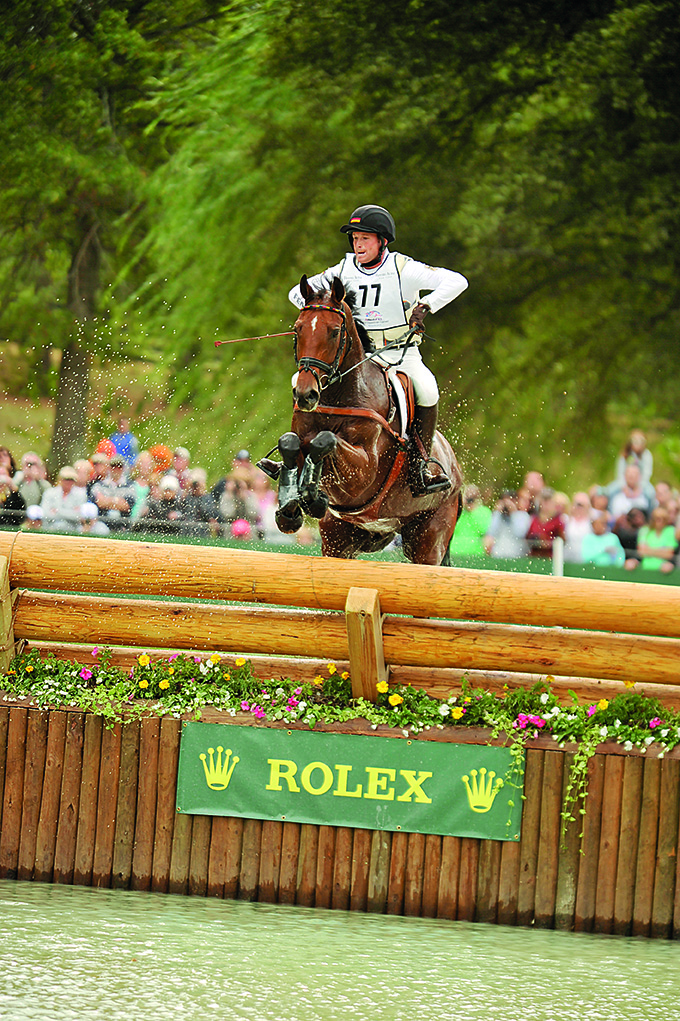
Trainer Jörn Warner researched this in his thesis. He found that the share of Thoroughbred blood in horses that are successful in the lower levels of eventing is lower (less than 30 percent) than in horses that are successful at the four- and five-star levels (more than 40 percent). Dr. Henning Frevert, the state stud manager of Neustadt/Dosse, formulated a model for the breeding value estimation for event horses as his thesis in 2016. He also found a positive correlation between the share of Thoroughbred blood and the success in international eventing competitions.
The general conditions for the use of Thoroughbred stallions have changed fundamentally over the past decades. The Thoroughbred has done a super job as a refining stallion for dressage and jumping, making itself to some extent superfluous. The decline in demand for Thoroughbred stallions is an indication of the successful refinement process, which is logical and no reason to panic. Eventing will not be possible in the future without the influence of Thoroughbred blood. For the breeding of dressage and show-jumping horses, it will be interesting to see whether a blood refreshment is sensible and necessary after a few generations.
“Boosting“ with Thoroughbreds is the new buzzword. Therefore, the English Thoroughbred will remain part of the breeding program for the Hannoveraner and the Rhineland riding horse. However, fewer stallions will be needed, but the quality demands will increase, also due to the specialization. The breeders’ demands regarding the basic gaits and the rideability or regarding the jumping ability have become greater.
Asking the experts
For Hannes Baumgart, a member of the Hannoveraner dressage licensing commission, a dressage horse breeder and trainer up to Grand Prix, the refinement process is complete: “We have so much noble blood in the lines that it is difficult to use a pure Thoroughbred. It has to be an exceptional Thoroughbred, which shows under saddle what the dressage rider wants, and then also passes this on to his offspring.”
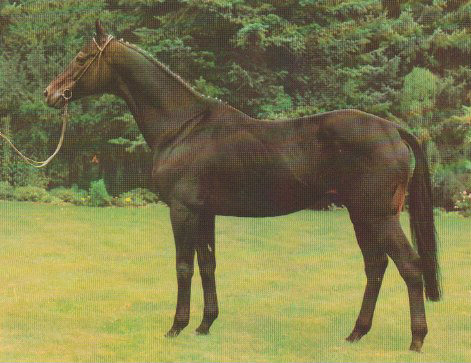
Roncalli xx
Norbert Bramlage, a private stallion owner and co-founder of the Association for Privately-Owned Hannoveraner Stallion Owners and a successful breeder, is basically a great friend of the Thoroughbred horse. From the stallions at his station, the Thoroughbred stallion Roncalli xx certainly holds a special position. With his sister Rafale xx, Bramlage built up a new dam line that has produced show jumpers and dressage horses up to the advanced level.
“The refinement process is actually complete. Today you see beautiful and typy horses that carry no Thoroughbred blood.
But I have to say, something is missing in both the breeding of show jumpers and of dressage horses, when the share of Thoroughbred blood diminishes. Show jumping is getting faster and faster, the dressage tests are getting more demanding because of the different movements that follow each other very quickly. If you want to be successful in the big sport today, you need a horse that immediately knows what you want, it must be able to anticipate. For that we need the blood horse.”
“The blood horse, however, requires fine handling and a fine way of riding. I have Roncalli xx in my breeding program now in the 4th/5th generation and will now use bloodstock again to improve body mobility and constitution besides the required intelligence. The stallion that I am going to use, must have the desired qualities himself. Therefore – it is always about the individual. We do not need the Thoroughbred per se, but the special one, the clever one. Unfortunately, a lot of generalization often takes place, which, by the way, does not only apply to Thoroughbred horses, but also to other breed populations.
The state stud always viewed as its responsibility to provide Thoroughbred stallions for refinement purposes. Does that still hold true?
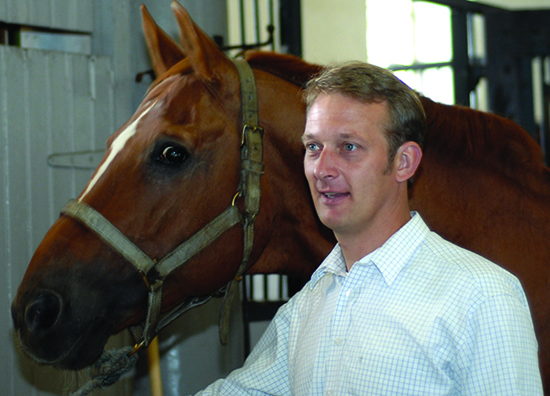
Dr Axel Brockmann, state stud manager in Celle, says: “I would love to stand a new Thoroughbred stallion, but it has become difficult to find the right one. I am mostly offered stallions that didn‘t work out on the racetrack. However, I have a good working relationship with Dr Astrid von Velsen-Zerweck in Marbach. She focusses on finding Thoroughbreds and Anglo-Arabians and making them available. When I for instance look at the Herwart von der Decken-Show, or look around at rural shows, we are well positioned in terms of type. We no longer need the Thoroughbred for refinement. The breeder of jumpers wants to have powerful horses. In dressage horse breeding, the Thoroughbred as a refining stallion is in tough competition with the Trakehner stallion, who was selected because of his basic gaits and his rideability.”
Among the state studs, the Marbach Main and State Stud holds a special position, as Dr Astrid von Velsen-Zerweck, the stud‘s manager, explains: “We specialize in refining stallions – Anglo-Arabians, Thoroughbred Arabians, Trakehners but also English Thoroughbreds – for the refinement and further development of Warmblood breeds. Marbach has always been home to blood horses. So this is nothing new, just a strengthening of what was already there. Our breeders are very open to refinement. We also cooperate with other state studs such as Celle or Schwaiganger, but also with private stallion owners.”
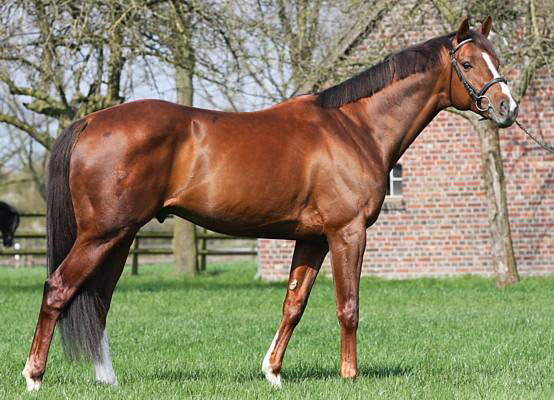
Asagao xx – new Thoroughbred blood…
“For example, we accepted Asagao xx, who passed his test in Marbach, in our program from the very beginning. In my opinion, the Thoroughbred has a place in the breeding of sport horses in the future, but not indiscriminately and not always. What is interesting about the Thoroughbred is the special composition of the muscular fibers, which is interesting for eventing, but also for dressage and jumping. Willingness to perform, willingness to fight, elasticity of movement, stamina and quick responsiveness are promoted by using Thoroughbred blood. I am cautious when it comes to health, because often Thoroughbreds are offered that were expelled from racing at an early age. One must absolutely question this.”
“The breeders of event horses are the ones who pay the most attention to having enough blood. You certainly can‘t do without blood there. In the disciplines of dressage and jumping, the future will show whether it is necessary to refresh the blood every now and then. I also recommend certain Thoroughbreds for these two disciplines. Il Divo xx, for example, has proven to be a good refining stallion for dressage horses. The Thoroughbred stallion Waugh xx is a relatively new addition. He himself jumps well. Dam‘s sire Monsun xx has made a name for himself in England as the sire of horses with jumping talent.”
This article first appeared in Die Hanoveraner, and is reproduced with thanks… And thanks again to Ludwig for another super contribution to our knowledge..
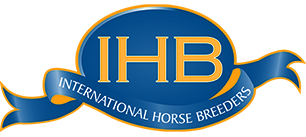
Time for Australian breeders to find the right stallion for 2022. Go to www.ihb.com.au now and make your selection! There’s a great range of stallions whatever you want to breed!
